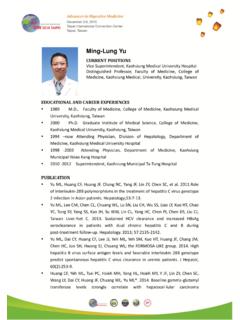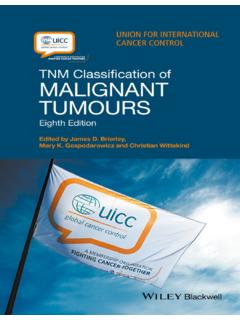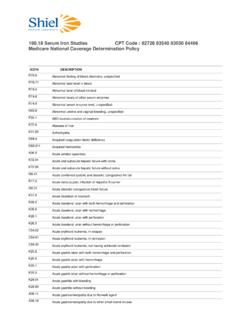Transcription of Ca vs Mel vs La - Stanford University
1 Applications of immunohistology to non-heme tumor differential diagnosis R V Rouse 7/22/2014 Table of Contents Page Undifferentiated panel 1. CK7/20 table 2. Breast carcinoma 2. Lung adenocarcinoma 3. Mesothelioma 4. GYN 5. GI 6. GU and germ cell 6. Misc carcinomas (liver, kidney, adrenal) 7. Squamous and sarcomatoid carcinoma 8. Sustentacular cells 8. Derm 9. Soft tissue keratin+ 9. Soft tissue CD34+ 10. Soft tissue other markers 11. Soft tissue no good markers 12. Undifferentiated panel: ca vs mel vs la Keratin AE1/3 mix, 90%+ of Ca Not CK7 or 20 or 5/6 to start with EMA, CEA as backups S100. 95%+ of Mel, but 10% of Ca are +. SOX10 may be better, more sensitive and specific HMB45, MelanA less sensitive, very specific LCA or CD20 90% of lymphomas Things that might be negative Anaplastic large cell lymphoma - use CD30, ALK, CD3.
2 Plasmacytoma use CD138, kappa, lambda Sarcomas use various markers, esp vascular CD31, CD34. Spindled/sarcomatoid carcinoma use CK5/6 and p63. Liver use HepPar1. Adrenal use Inhibin, MelanA, SF1. Seminoma/germinoma use OCT3/4 or SALL4. Non-heme IPOX 7/22/2014 Rouse p 2. Carcinoma primary site What is the DDx? Choose complementary antibodies (check the history first). CK7/20: USE THE TABLES. Most use is for ADENOCARCINOMAS, Little data for undifferentiated Ca UNKNOWN PRIMARY: immunohistochemistry CK7+20+ CK7-20+. Ovary mucinous 90% Colorectal adeno 80%. Transitional cell 65% Merkel cell 70%. Pancreas adeno 65% Gastric adeno 35%. Cholangio 65% Excluded tumors 5%. Gastric adeno 40% Breast; Carcinoid lung;. Excluded tumors 5% Cholangio; Esoph squam.
3 Carcinoid; Germ cell; Esoph Germ cell; Lung all types;. squam; Head/neck squam; Hepatocellular; Ovary;. Hepatocellular; Lung small Pancreas adeno; Renal cell Ovary non- adeno; Transitional cell;. mucinous; Renal adeno Uterus endometrioid CK7+20- CK7-20- Ovary non-mucinous 100% Adrenal 100%. Thyroid (all 3 types) 100% Seminoma & YST 95%. Breast 90% Prostate 85%. Lung adeno 90% Hepatocellular 80%. Uterus endometrioid 85% Renal adeno 80%. Embryonal 80% Carcinoid GI & lung 80%. Mesothelioma 65% Lung small cell & squam 75%. Transitional cell 35% Esoph squam 70%. Pancreas adeno 30% Head/neck squam 70%. Cholangio 30% Mesothelioma 35%. Excluded tumors 5% Excluded tumors 5%. Colorectal adeno; Ovary Breast; Cholangio; Lung mucinous, Seminoma, Yolk adeno; Ovary; Pancreas sac tumor adeno; Transitional cell Breast Carcinoma GATA3 90%, BRST2 (GCDFP15) 60%+, quite specific (salivary and skin adnexal tumors pos).
4 ER 75%+, PR 60%+ (lung most neg to focal/weak but up to 5% strong pos in one report). S100 15%+, (lung neg). CK7+20- 90% (lung is also 7+20-). Mammaglobulin breast 85%, cholangio, GI, lung adenoca 10-20%. ER, PR +. Breast Ovary Endometrium Papillary thyroid Skin adnexal tumors Sarcomas Meningioma (PR only). Solid-pseudopapillary neoplasm of pancreas (PR only). Non-heme IPOX 7/22/2014 Rouse p 3. Breast carcinoma type E cadherin Ductal positive, Lobular negative Works for invasive and in situ Breast vs Lung Panel BRST2 (60%) or GATA3 (90%) Breast pos Lung neg ER, PR favor breast but not sensitive TTF1 (70%) or Napsin (80%) - Lung pos Breast neg Metaplastic/Sarcomatoid Carcinoma CK5/6 about 50%. P63 60%. AE1/3 40%. Smooth muscle actin 70%. Breast invasive vs in situ Myoepithelial cells absent in invasion Smooth muscle actin stains myoepithelial cells; myofibroblasts frequently confusing Calponin cytoplasmic, a bit more specific than actin, easier to interpret at low power than p63.
5 P63 nuclear, most specific but may be harder to see at low power if not strong Calponin vs p63: personal preference or use both Occasionally get divergent results Usually go with the positive Breast papilloma vs in situ Calponin and/or p63. Are myoepithelial cells present throughout the lesion? Lung Adenocarcinoma CK7+20- 90%, TTF1 70% (also thyroid +), Napsin 80% (also some RCCa +). CD56 5%, CK5/6 10%, p63 0-25% focal, PAX8 neg Lung squamous Ca, both basaloid and usual types CK7-20- 70% (CK7+20- 25%). TTF1/Napsin neg, CD56 0-10%, PAX8 neg P63, 34BE12 and CK5/6+ 100%. Lung small cell (oat cell) Ca CK7-20- 90%, CK20 rare TTF1 90%, CD56 95%. P63 neg, CK5/6 neg, 34BE12 scattered pos cells 12%, no confluent positive cases Synaptophysin 50%, Chromogranin 40%.
6 Keratin usually absent to patchy or dot like Oat vs Merkel cell TTF1 Oat 90%, Merkel neg CK20 Oat neg, Merkel 90%. Keratin may be dot like for both Chromogranin and synaptophysin variable in both Merkel 35-75% pos for TdT, do not confuse with ALL. Non-heme IPOX 7/22/2014 Rouse p 4. Mesothelioma Reactive vs neoplastic mesothelium: EMA, IMP3, Glut1, p53: favor mesothelioma if positive Desmin favors reactive if positive Pleural Mesothelioma Lung Adenoca Calretinin 90% (nuclear) 15%. CK5/6 90% (Benign mesos freq neg) 10%. D2-40 (podoplanin) 90% 0-7%. WT1 90% 25%. TTF1 (nucl) / Napsin (cytopl) neg 70-80%. CD15 very rare 95%. CEA very rare 90%. BerEp4 15% 95%. MOC31 10% 100%. (TAG72) 5-15% 85%. Lung vs Mesothelioma Panel Two or three of each of meso pos and lung pos markers should be enough WT1 not useful vs lung D2-40.
7 Kaposi sarcoma 100%. Angiosarcoma 72%. Seminoma 100%. Nonseminomatous germ cell negative Mesothelioma 90%. Lung adenocarcinoma 0-7%. Various carcinomas 20-40%. Dermatofibroma 100%. Ovary serous Peritoneal mesothelioma Calretinin 7-34%, rare in our studies 100% (nuclear). CK5/6 17% 100%. Thrombomodulin 30% 74%. PAX8 75-90% 9% (weak). BerEp4 100% 9%. CD15 60% neg S100 27% neg (TAG72) 80% neg MOC31 97% 3%. WT1 stains both (but good for ovary vs breast). Ovary serous vs mesothelioma panel BerEp4 Ovary+. MOC31 Ovary+. PAX8 Ovary+. Calretinin Mesothelioma+. Non-heme IPOX 7/22/2014 Rouse p 5. GYN. Ovary vs Breast PAX8. Ovary surface epithelial carcinomas 70-100%. Only mucinous 10-59%. Breast negative Ovary Serous Ca CK7+20- 100%. WT1 90%. 90% mesotheliomas, 25% lung adenoca, 5% breast Neg: colorectal, endometrial (incl pap serous), panc, bile duct, ovary mucinous WT1 other reactivity 90% DSRCT.
8 75% Wilms 55% Rhabdo 12% Neuroblastoma 0% PNET. 30% Burkitt and lymphoblastic Pos AML. Angiosarcoma (cytoplasmic). Ovary Mucinous CK7+20+ 95%. MUC2 and MUC5AC various mucinous tumors +. Ovary, appendix, colon, breast, stomach, endocervix CDX2 mucinous ovary and GI tract all sites, pancreas +. Ovary CK7/20. Serous 7+20- 100%. Mucinous 7+20+ 95% (rule out stomach, pancreas, bile duct). Colorectum 7-20+ 90%. Endometrial vs Endocervical (applies to glandular areas only). Endometrial Endocervical ER and vimentin Usually diffuse pos Usually neg or focal P16 and CEA Usually neg or focal usually positive Endometrial stromal vs Smooth muscle Muscle Stromal Caldesmon 70% 5%. CD10 35% 95%. Desmin 90% only in areas of muscle differentiation B-catenin neg 50-100%.
9 Complete mole p57 neg vs partial mole and hydropic change p57 pos MUC4 may be useful for identifying implantation site trophoblast Non-heme IPOX 7/22/2014 Rouse p 6. GI Tract Colorectum CK7-20+ 90%. MUC2 and MUC5AC various mucinous tumors +. Ovary, appendix, colon, breast, stomach, endocervix CDX2. Colorectal >90%. Mucinous carcinomas of all organs including ovary, pancreas positive from 40-100%. <5% lung, prostate, breast, ovarian serous Carcinoids: ileum and appendix >90%, other sites variable but frequently negative, lung negative TTF1 stains 50% of pulmonary and 0% of GI. Stomach, Pancreas, Bile Duct No great markers Wide range of CK7&20. Stomach 50%+ HepPar1. CA19-9 not specific for pancreas Pos: Colon, ovary, lung, cholangio 0-5%: Liver, breast, mesothelioma Esophageal adenocarcinoma frequently TTF1 and napsin +.
10 GU & Germ Cell Prostate well/mod diff PSA or and PSAP (prost acid phos) 95% pos All very specific, one is usually enough if untreated, mod diff carcinoma ERG very specific but 50% sensitive Prostate vs TCCa (high grade or treated Ca). For poorly diff TCCa: GATA3 may be most sensitive and specific Backups p63 (85%) and HMWCK (CK5/6 or 34BE12 60%). Uroplakin and thrombomodulin do not work for poorly diff TCCa For poorly diff prostate ca, more sensitive (>90%) than PSA (may be neg in 10%). Both very specific Prostate Ca vs benign In general, for small foci, IPOX can prove benignancy but not prove malignancy Small foci that stain as cancer are usually best left at ASAP (see surgpathcriteria). Basal epithelial cells (not myoepithelial cells) absent in carcinoma High molecular weight keratin - 34BE12 or CK5/6 cytoplasmic, p63 nuclear Basal cells may be patchy Presence of a basal layer virtually rules out invasive Ca (Gold standard?)





